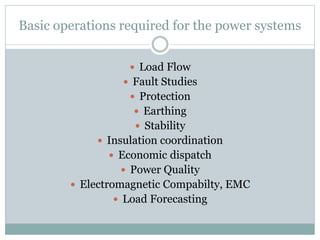powersystems1-150620165015-lva1-app6892.pptx
- 1. NAME : Ankita Karmakar DEPARTMENT: Electrical Engineering ROLL NO : 35001622059 SUBJECT: Power System-II SUBJECT CODE : PC-EE-601 SEMESTER : 6th YEAR : 3rd SESSION : 2022-2025 COLLEGE : Ramkrishna Mahato Government Engineering College
- 2. Basic concepts of Power Systems Fundamentals of : ’éŚ Power Generation ’éŚ Transmission Lines ’éŚ Dristibution Lines
- 3. Basic operations required for the power systems ’éŚ Load Flow ’éŚ Fault Studies ’éŚ Protection ’éŚ Earthing ’éŚ Stability ’éŚ Insulation coordination ’éŚ Economic dispatch ’éŚ Power Quality ’éŚ Electromagnetic Compabilty, EMC ’éŚ Load Forecasting
- 4. Basic Structure of the Electric System
- 5. Generating Stations ’éŚ Fossil Fuel ’éŚ Hydroelectric ’éŚ Nuclear ’éŚ Geothermal ’éŚ Renewable ’üČ Photovoltaics ’üČ Solar Thermal ’üČ Wind ’üČ Bio-gas
- 6. Transmission Lines ’éŚ High Voltage 69 kVŌĆō500 kV ’éŚ Power Capacity 50ŌĆō1,000 MW ’éŚ Carry power long distances ’éŚ Low energy losses, P=V┬▓/R ’éŚ Large structures
- 7. Distribution Lines ’éŚ Primary; 12 ŌĆō 34 kV AC ’éŚ Secondary: 480 V ŌĆō 120 V AC ’éŚ Power capacity: 10 ŌĆō 40 MW ’éŚ Shorter distances, higher losses ’éŚ Smaller overhead structures ’éŚ Underground
- 8. Power Analysis In AC: 1 phase: u=Um.cos(wt) i=▒§│Š│”┤Ū▓§(Ę╔│┘-╬Ė) p=u.i=UmImcos(wt)cos(wt-╬Ė) (instantaneous value of the power) In DC: P=U.I
- 9. Power Analysis p=u.i= Umcos(wt) ▒§│Š│”┤Ū▓§(Ę╔│┘-╬Ė)
- 10. Power Analysis p=u.i=UmImcos(wt)cos(wt-╬Ė) p=UI cos╬Ė (1+cos(2wt))+UI sin╬Ė sin(2wt) active component reactive component P=UI cos╬Ė (active power) {W} Q=UI sin╬Ė (reactive power) {VAr} Cos╬Ė= (Power factor)
- 11. Power Analysis S=P+jQ (Complex Power) S┬▓=P┬▓+Q┬▓ (Apparent power) {VA}
- 12. Power Analysis 3 phase systems: Up=Ua=Ub=Uc Ip=Ia=Ib=Ic
- 13. Power Analysis Y Connection Il=Ip Ul= Up P=3UpIpcosŽå Q=3UpIpsin Žå S=3UpIp
- 14. Power Analysis Delta Connection Ip=IlŌłÜ3 Ul=Up, P=ŌłÜ3UlIlcosŽå (Generally) Up= 220 V Ul= 220.ŌłÜ3 = 380 V













